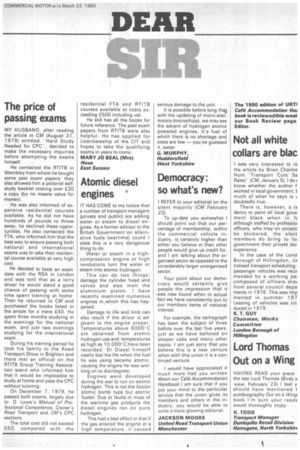Atomic diesel engines
Page 71

If you've noticed an error in this article please click here to report it so we can fix it.
IT HAS COME to my notice that a number of transport managers (private and public) are adding water or steam to diesel engines. As a former advisor to the British Government on alternative fuels (wartime) could I state this is a very dangerous thing to do.
Water or steam in a highcompression engine at high revolutions turn the water or steam into atomic hydrogen.
This can do two things: damage the cylinder head and valves and also melt the aluminium piston. I have recently examined numerous engines in which this has happened.
Damage to life and limb can also result if the driver is adjacent to the engine proper. Temperatures above 6000cC are obtained from atomic hydrogen use and temperatures as high as 10,000'C have been recorded. Dr Diesel himself nearly lost his life when the fuel he was using became atomic, causing the engine he was working on to disintegrate.
Engines were developed during the war to run on atomic hydrogen. This is not the fission atomic bomb type but atomic fusion. Due to faults in most of the wartime gas products the diesel engines ran on pure hydrogen.
This had a bad effect in that if the gas entered the engine at a high temperature, it caused serious damage to the unit.
It is possible before long that with the updating of micro electronics (microchips), we may see the advent of hydrogen atomic powered engines. It's fuel of which there is no shortage and costs are low — you've guessed it, water.
G. MURPHY, Huddersfield West Yorkshire
































































































































